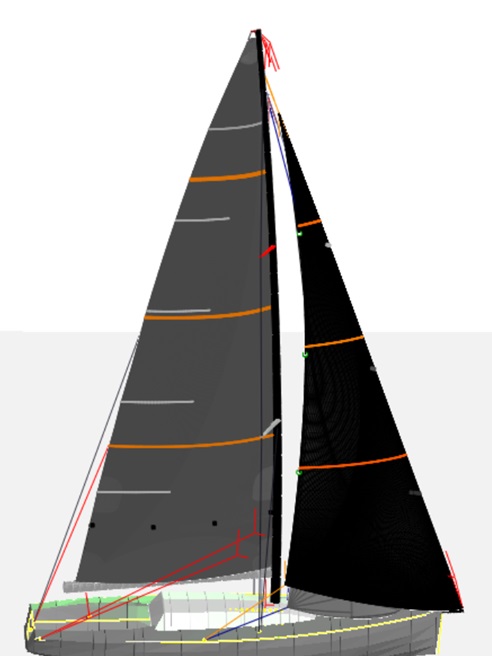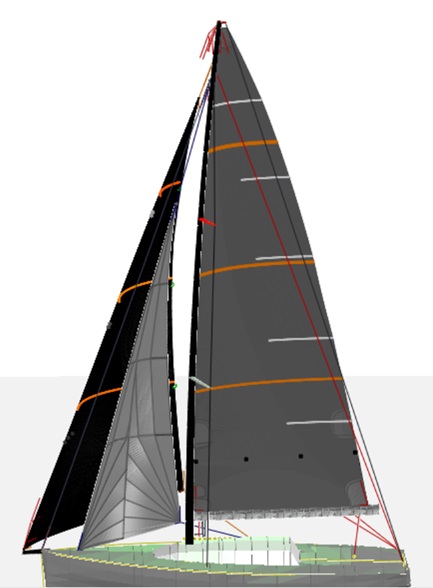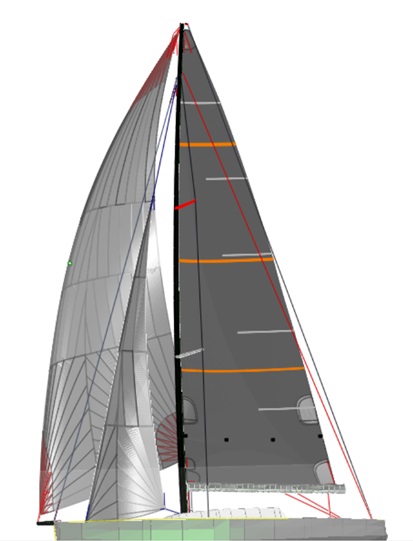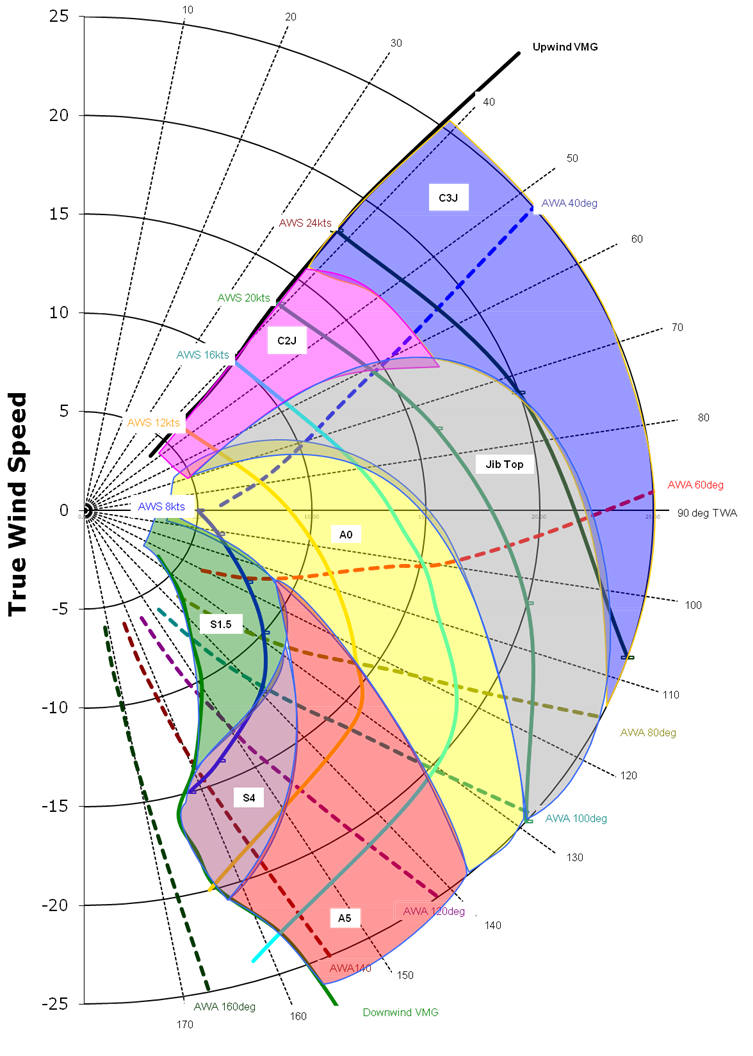Turbo-Charged Reaching
The average IRC yacht now has non overlapping headsails which can be inhauled and a medium roach mainsail and can go upwind very effectively in all but the lightest of conditions. Downwind they use large spinnakers and also have good performance resulting in a set up which works perfectly for windward leeward racing. The problem these boats have is that the jibs are not hugely effective off the breeze and their large spinnakers are too deep to sail tight angles resulting in a large range of angles where you are unable to sail at 100% of your boats targets. For anyone racing offshore or round the cans regattas like Cowes Week this is a real problem as they are potentially giving away a lot of time on the water.
Luckily, under IRC the penalty for additional spinnakers is low and there is no penalty for additional jibs as only the largest one is measured. As a result there are two great options to turbo-charge your reaching performance and always be able to sail at 100% of targets no matter what the wind angle.
1 - The Jib Top (and Genoa Staysail)

 A jib top is a high clewed reaching jib which is much more efficient once the sheets are eased and used between a Code 0 and a jib in over 12kts TWS.
A jib top is a high clewed reaching jib which is much more efficient once the sheets are eased and used between a Code 0 and a jib in over 12kts TWS.
It is sized the same as your largest jib so there is no rating penalty. Jib Tops are traditionally flown from the forestay but on boats with a bowsprit it has become popular to fly them on a torsion cable forward of the bow.
Combining the Jib Top with a Genoa Staysail increases and pushes the area of the sail plan forward, helping to balance up the helm when the boat is pressed on a reach. In above 22kts this sail combination is incredibly fast. In combination with a reefed main the boat is perfectly balanced and much faster than using a smaller headsail and full main (20kts TWS sail performance comparison chart).
 JT / Staysail Race Example
JT / Staysail Race Example
It's the Dieppe race and you turn onto the final leg, a reach from Brighton to the finish in Dieppe. In the prevailing wind direction and the breeze in the English Channel is a solid 20kts. A Jib Top would be the perfect sail for the 65 mile leg at 95-100 degrees TWA and 18-22kts TWS. Performance is 8-10% faster than you would manage under the J3.
If you aren’t sure that 8 % sounds that much consider the numbers. In your 40 footer you would be able to maintain a 10kt average speed with the J3 but with the JT and Genoa staysail the speed has jumped to 10.8-11kts average. You save half an hour over the leg for no penalty to your rating!
2 - The Code 0

 The code 0 is the flattest sail you can have with it still measuring as a spinnaker. The definition is when the mid-girth measures 75% of the foot length. These sails can be used for very tight reaching in light and medium winds and for broader reaching in up to 22kts. They can easily increase performance by 10% in comparison to a jib at tighter angles than a spinnaker can be carried.
The code 0 is the flattest sail you can have with it still measuring as a spinnaker. The definition is when the mid-girth measures 75% of the foot length. These sails can be used for very tight reaching in light and medium winds and for broader reaching in up to 22kts. They can easily increase performance by 10% in comparison to a jib at tighter angles than a spinnaker can be carried.
Depending on your boat it is possible to have either a fractional or masthead code 0. This is based on the boat's performance characteristics, where it will fit into the existing sail inventory and halliards available. The sail can be flown from a bowsprit or from the spinnaker pole and either be on a furler or launched out of a bag like a normal spinnaker.


Sized approximately half way between a jib and spinnaker, the Code zero is incredibly versatile and should be the first port of call for anyone looking to build a reaching, sail wardrobe.
Code 0 Race Example
You have just rounded the Fastnet Rock and are heading to the turning mark. It’s 15 kts and the 165 mile leg back to the Scillies is about to commence. It’s prevailing wind conditions so the wind angle is between 100 and 120 degrees TWA.
Normally you could cruise along at 10 kts if you were lucky. The boat would feel a little dead under the J2 and if you get a little low the performance really drops off a cliff but it’s still too tight for any of your spinnakers. Maybe you would decide to sail a little high then pop the spinnaker later?

Not to worry though. This time you have your code zero. You unfurl and head off comfortably averaging 11.5kts straight down the rhumb line. The boat feels great and you leave anyone under jib in your wake. Suddenly the leg takes 14hrs 20 mins rather than 16hrs 30 mins. Because you looked at the forecast and knew this leg would arrive you fitted the zero into your quota of spinnakers and saved at least 2hrs 10mins for no rating penalty! (14kts TWS performance comparison chart)
These are fairly common scenarios in offshore racing so it is worth looking at the events in your calendar and seeing if a specialist reaching sail could make the difference and get you on the podium. There is nothing more frustrating than loosing 2hrs plus in a race because you didn’t have the right sail inventory.
We can provide a sail polar chart for your boat to show where in the inventory these sails could fit and what the best option for you is. This will depend on your boat and the events you plan to race in.
 Where once these sails were uncommon, it is now incredibly risky to not carry them for offshore or point to point racing. We are often asked how much difference Code 0 can make so have developed our sail performance comparison charts to help show relative performances of these sails.
Where once these sails were uncommon, it is now incredibly risky to not carry them for offshore or point to point racing. We are often asked how much difference Code 0 can make so have developed our sail performance comparison charts to help show relative performances of these sails.
We love to develop specialist sails for specific boats and campaigns and enjoy nothing more than seeing happy customers on the podium of the biggest events. Don’t just make up the fleet numbers, take home the silverware!
Request a Tailored Quote










